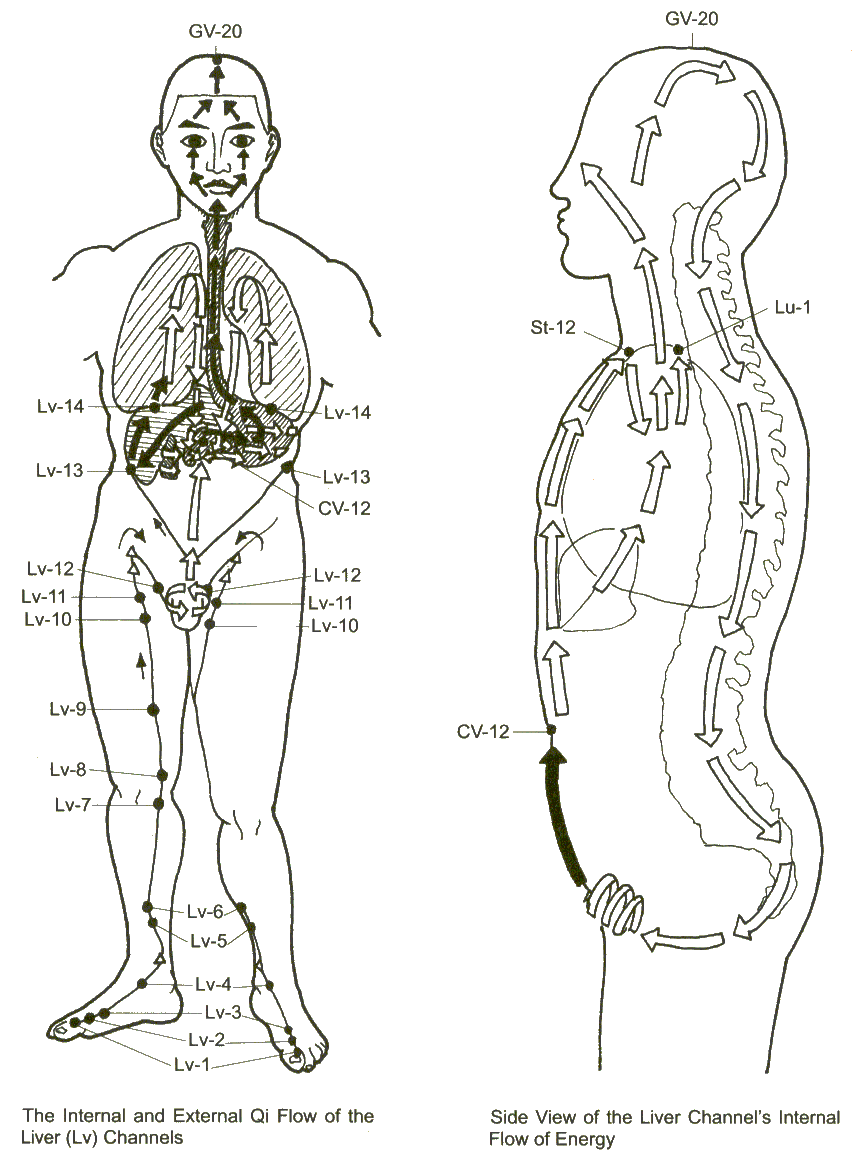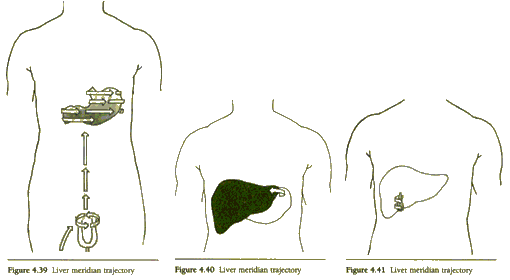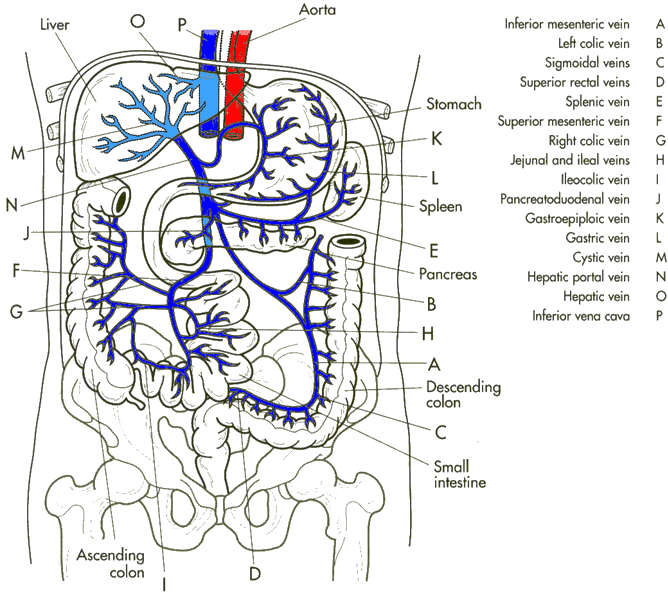
Liver: Wood-energy yin organ

Liver:
Wood-energy yin organ
The liver is called the 'General' or 'Chief of Staff' and is responsible for filtering, detoxifying, nourishing, replenishing, and storing blood. The liver stores large amounts of sugar in the form of glycogen, which it releases into the blood stream as glucose whenever the body requires extra infusions of metabolic energy. The liver receives all amino acids extracted from food by the small intestine and recombines them to synthesize the various forms of protein required for growth and repair of bodily tissues.
The liver controls the peripheral nervous system, which regulates muscular activity and tension. The inability to relax is often caused by liver dysfunction or imbalance in Wood energy. Liver energy also controls ligaments and tendons, which together with muscles regulate motor activity and determine physical coordination. Liver function is reflected externally in the condition of finger- and toenails and by the eyes and vision. Blurry vision is often a result of liver malfunction rather than an eye problem, and even Western medicine recognizes the symptomatic yellow eyes of liver jaundice.
Through its association with Wood energy, the liver governs growth and development, drive and desires, ambitions and creativity. Obstruction of liver energy can cause intense feelings of frustration, rage, and anger, and these emotions in turn further disrupt liver energy and suppress liver function, in a vicious self-destructive cycle.
|
Liver |
|
| Paired Organ | Gallbladder |
| Color | deep green |
| Peak Hours | 1am-3am |
| Physical Branches | eyes, tendons, tears, nails |
| Functions | stores the blood, governs the free flow of qi |
Liver: Psycho-Emotional Aspects
The Liver is responsible for planning and creativity, as well as instantaneous solutions or sudden insights; it is therefore considered The General in Charge of Strategy. The Liver houses the body's Hun and governs fright. Its positive psycho-emotional attributes are kindness, benevolence, compassion, and generosity; its negative attributes are anger, irritability, frustration, resentment, jealousy, rage, and depression. The Liver is also called the "root of resistance to fatigue." Whenever the Liver is not functioning properly (stagnate or excessively Hot due to suppressed emotions) the patient can experience fatigue as well as physical weakness.
The Liver Channel Pathway, Acupuncture Points, and Internal Trajectories
Beginning by the inside of the big toenail, the liver channel crosses the top of the foot, passes in front of the inside ankle and up the inner aspect of the leg through SP-6 close behind the edge of the bone. It continues past the knee along the inner thigh to the groin and pubic region, where it circulates the external genitals. It connects with the conception vessel in the lower abdomen and continues up around the stomach to enter both the liver and gallbladder. Connecting with two surface points on the ribs, the channel then dips into the ribcage, runs up through the throat, opening to the eye, and ends at the crown of the head where it connects with the governing vessel. A branch circles the mouth. From within the liver, another internal branch reaches the lungs, and this restarts the cycle of qi.

Internal Trajectories of the Liver Meridian
The liver meridian rises up the medial sides of the legs from the big toes.
[It then] comes into the yin organs [sexual organs] and circles around the yin organs. Then it passes through the small abdomen; then up to and surrounding the stomach; then it permeates the liver. and spirally wraps the gallbladder. It comes up and passes through the diaphragm, up the sides of the ribs, up behind the trachea, to behind the throat. Then it rises up the cheeks, comes into the eyes, passes up the forehead and meets the du mai at the top of the head. . . . A branch separates from the liver, passes up through the diaphragm and goes to the lungs.

In this case, "the inside of the chest" is seen as the sides of the chest, around PC-1. In general, we should be aware that the inside of the chest has a wider meaning which depends on context. It can be inside the chest, CV-17, the sides of the chest, as well as some other less common referents. In coming down through the diaphragm it probably passes through the esophagus and then the stomach, before it passes to and spirally wraps the liver. After this, it permeates the gallbladder. In circling around on the inside of the lining of the ribs and the sides of the body it passes out to LV-13, and then to ST-30.
After circling around the sexual organs it passes into the small abdomen, the kidney reflex area, and an area below the umbilicus described by or including CV-2, CV-3, CV-4. Then it passes up to and surrounds the stomach, permeates the liver, and spirally wraps the gallbladder. When it passes up and out to the sides, it surfaces at LV-13 and re-enters internally at LV-14.
The trajectory that passes up to and meets the du mai (governing vessel) joins at GV-20. The branch passes up to the lungs, then comes down to the middles warmer and "surrounds CV-12". Once at CV-12, the cycle of the twelve meridians is ready to start again, as the lung meridian has its origin at CV-12. This interpretation if the meridians beginning at CV-12 and ending at CV-12 so that they make a complete circuit is one that comes from the Shisi Jing Fa Hui.
The Ling Shu contains another very different idea about the pathways of the liver meridian which also brings it back full circle to the lung meridian. This interpretation is particularly interesting in that the trajectory includes the du mai and passes up the abdomen to enter the chest at ST-21.
The liver meridian passes up to the liver. [From the liver] it passes up through to the lungs, rises up to the throat, to the nasal pharynx, to the nose. A branch splits and rises to the top of the forehead, to the top of the head. It then goes down around the spine into the sacrum-coccyx; this is the du mai. [It passes inside and] spirally wraps the yin organs. It passes up to the lining of the abdomen, enters at ST-12, passes down into the lungs and comes out at tai yin [the lung meridian].
This trajectory is paralleled in complexity only by the kidney meridian, and seems to be even more inclusive, as the du mai is seen as its branch. It is seen to spirally wrap all the yin organs. It definitely provides an alternate route by which the qi passes from the liver to the lung meridian to complete the circuit. Whichever interpretation we accept, we can see that the internal connections of the meridians play an important role in the circulation of the qi through the twelve meridians, beginning at CV-12 and ending at CV-12, or beginning and ending at the lung meridian ready to circle again.
According to the Chinese, the liver 'stores the blood' and is associated with Wood energy, which is an upward moving force. This relates very much with Western physiology, as just about all the veins of the gastrointestinal tract flow into the liver via the Hepatic Portal vein. From there the blood flows 'upwards' through the liver into the Inferior Vena Cava. Here's a schematic of the Hepatic Portal system:
